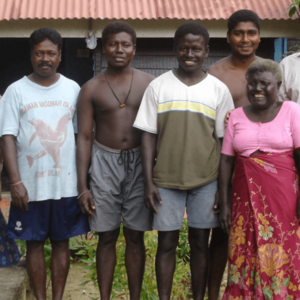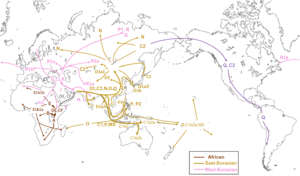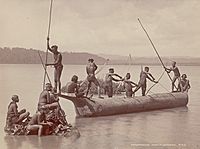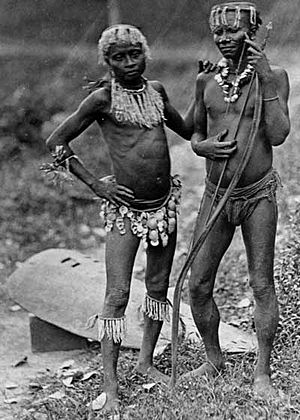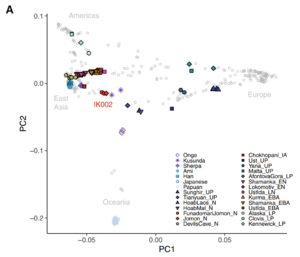Andamanese peoples facts for kids
The Andamanese are the native people who live on the Andaman Islands. These islands are part of India and are located in the Bay of Bengal in Southeast Asia. The Andamanese are often called Negrito people because of their dark skin and short height. For thousands of years, all Andamanese groups lived by hunting and gathering food. They seem to have lived mostly separate from other people for a very long time. It's thought they settled on the Andaman Islands about 26,000 years ago, during the last big ice age.
The Andamanese people include several groups: the Great Andamanese and Jarawas from the Great Andaman islands, the Jangil from Rutland Island, the Onge from Little Andaman, and the Sentinelese from North Sentinel Island. In the late 1700s, when they first had regular contact with outsiders, there were about 7,000 Andamanese. Over the next 100 years, their population dropped a lot. This was mainly due to diseases from outside and losing their land. Today, only about 400–450 Andamanese remain, and the Jangil group is no longer around. Only the Jarawa and Sentinelese groups still live mostly on their own, avoiding contact with people from outside.
The Andamanese are recognized as a special 'Scheduled Tribe' in India's constitution.
Contents
History
Until the late 1700s, the Andamanese people kept their culture, language, and genes safe from outside influences. They were very protective and would even kill foreigners who were shipwrecked on their islands. The islands were also very far away from other places. Because of this, the different tribes and their unique languages are believed to have developed on their own for thousands of years.
The famous explorer Marco Polo wrote about the Andamanese in 1294. He described them in his book, The Travels of Marco Polo:
The people are without a king and are Idolaters, and no better than wild beasts. And I assure you all the men of this Island of Angamanain have heads like dogs, and teeth and eyes likewise; in fact, in the face they are all just like big mastiff dogs! They have a quantity of spices; but they are a most cruel generation, and eat everybody that they can catch, if not of their own race. They live on flesh and rice and milk, and have fruits different from any of ours.
Where the Andamanese Came From
Experts believe the Andaman Islands were settled less than 26,000 years ago. The people who arrived were not directly related to the very first humans who left Africa. Some studies suggest that modern humans came to the Andaman islands from northeast India. They might have used a land bridge that connected the islands to Myanmar during the last Ice Age. This idea fits with what we know from language studies and old climate information.
It was once thought that the ancestors of the Andamanese were part of the first big human migration out of Africa. This migration went along the coast of Asia towards Southeast Asia and Oceania. The Andamanese were seen as a perfect example of a group called "Negrito," who were thought to live all over Southeast Asia and look similar. However, today, many scientists doubt that a single "Negrito" group ever existed. Their similar looks might be due to adapting to similar environments or sharing some history.
Colonial Times
The Andamanese people's isolated life changed when the British set up colonies on the islands. The Andamanese had no protection against common diseases from other parts of the world. Because of this, many Jarawa people died from illnesses like pneumonia, measles, and flu within four years of the British arriving in 1789. By 1875, the Andamanese were "dangerously close to disappearing." In 1888, the British government started a policy of giving gifts to the Andamanese. This continued until India became independent from the British Empire.
Problems grew between the British and the Andamanese. British officials even introduced alcohol to the Andamanese. In the mid-1800s, the British government in India also started sending prisoners to the islands. More and more people from India and the Karen ethnic group arrived, both as settlers and prisoners.
In 1867, the British sent an expedition to rescue sailors whose ship, the Assam Valley, had crashed on the Andamanese islands. The Onge people attacked the expedition when they got close to the islands, forcing them to leave. Four Victoria Cross medals were given to members of this expedition for their bravery.
In 1923, a British bird expert and anthropologist named Frank Finn visited the islands in the 1890s. He described the Andamanese as "The World's Most Primitive People." He wrote:
I used to envy the pigmies their simple costume, which in the case of the ladies was a wisp and a waistband, and in that of the men, nothing at all. Their interests are looked after by an English Civil Servant, who has to see that no one sells them drink, or interferes with them in any way; but even this officer-in-charge, as he is styled, dares not go among them where he is not known, and considerable tact is required in getting an introduction to the local chief.
In the 1940s, the Jarawa were attacked by Japanese forces because the Jarawa were hostile towards them. Many people criticized this Japanese attack as a war crime.
Recent History
In 1974, a film crew and an anthropologist named Triloknath Pandit tried to make friendly contact with the Sentinelese. They left a pig, some pots, fruit, and toys on the beach of North Sentinel Island. One of the islanders shot the film director in the leg with an arrow. The next year, European visitors were also driven away with arrows.
On August 2, 1981, a cargo ship from Hong Kong called the Primrose got stuck on a reef near North Sentinel Island. A few days later, the crew saw small, dark-skinned men carrying spears and arrows, building boats on the beach. The captain asked for guns to defend his crew, but he didn't get them. Rough seas kept the islanders from reaching the ship. After a week, the crew was rescued by an Indian navy helicopter.
On January 4, 1991, Triloknath Pandit made the first known friendly contact with the Sentinelese.
Until 1996, the Jarawa usually met visitors with arrows. Sometimes, they attacked and killed people who were illegally hunting on their land. They also killed some workers building the Andaman Trunk Road (ATR), a road that goes through Jarawa lands. One of the first peaceful contacts with the Jarawa happened in 1996. Settlers found a teenage Jarawa boy named Enmei near Kadamtala town. The boy had a broken foot and couldn't move. They took Enmei to a hospital, where he was well cared for. Over several weeks, Enmei learned a few words of Hindi before going back to his jungle home. The next year, Jarawa individuals and small groups started appearing along roadsides. They sometimes went into settlements to steal food. The ATR road might have made it harder for the Jarawa to find their traditional food sources.
On November 17, 2018, an American missionary named John Allen Chau was killed when he tried to introduce Christianity to the Sentinelese tribe. The Sentinelese are protected from contact with the outside world. Indian law forbids trips to North Sentinel Island. Local fishermen brought Chau close to the island, and they were later arrested during the investigation into his death. Indian authorities tried to get Chau's body back but were not successful.
Tribes
There are five main groups of Andamanese people:
- Great Andamanese: They traditionally lived in the Great Andaman islands but now live on Strait Island. In 2010, there were 52 of them.
- Jarawa: They traditionally lived in the southern part of South Andaman Island. Now they live in the western and central parts of South and Middle Andaman Islands. In 2011, there were 380 of them.
- Jangil: Also called Rutland Jarawa, they lived on Rutland Island. This group died out by 1931. The last person was seen in 1907.
- Onge: They live on Little Andaman. In 2011, there were 101 of them.
- Sentinelese: They live on North Sentinel Island. It's estimated there are between 100 and 200 of them.
By the late 1700s, about 5,000 Great Andamanese lived on Great Andaman. They were made up of ten different tribes, each with their own language. Their population quickly fell to 600 in 1901 and to just 19 by 1961. It has slowly grown since then, after they moved to a special area on Strait Island. As of 2010, their population was 52, and they are a mix of the original tribes.
The Jarawa originally lived in southeastern Jarawa Island. They moved to the west coast of Great Andaman after the Great Andamanese. The Onge once lived all over Little Andaman but are now limited to two special areas on the island. The Jangil, who lived on Rutland Island, were gone by 1931. Only the Sentinelese still live in their original home on North Sentinel Island, mostly undisturbed. They have strongly resisted all attempts by outsiders to contact them.
Languages
The Andamanese languages are seen as a unique language family in India. They are different from the other major language families found there.
While some people have suggested links to other language families, most experts agree that Andamanese languages form their own separate group. In fact, they are thought to be two unrelated language families: Greater Andamanese and Ongan.
Culture
Before they had contact with outsiders, the Andamanese were strict hunter-gatherers. They did not farm plants. They lived by hunting wild pigs, fishing, and gathering food. Their only weapons were bows, axes, and wooden harpoons. In the 1800s, the Andamanese did not know how to make fire. Instead, they carefully kept burning embers from fires started by lightning strikes in hollow trees.
The men wore belts made of hibiscus plant fibers. These belts held useful tools and weapons for hunting. The women wore a traditional dress made of leaves held by a belt. Many of them also painted their bodies. They usually slept on leaves or mats. Their homes were either permanent or temporary, and all were built by hand.
Some tribe members were believed to have special powers. They were called oko-pai-ad, meaning "dreamer." People thought they could influence the tribe and bring bad luck to those who didn't believe in their abilities. Traditional healers helped with health care. They mostly used herbal medicines. The islanders used many different types of medicinal plants. In total, 77 traditional healers were found, and they used 132 different medicinal plants. Tribe members found many ways to use leaves in their daily lives, including for clothing, medicine, and sleeping.
Anthropologist A.R. Radcliffe Brown believed that the Andamanese had no formal government. Instead, they made decisions together by group agreement.
Religion
The native Andamanese religion is a form of animism, which means they believe that spirits live in natural objects and places. Worshipping ancestors is an important part of their religious traditions. Andamanese stories say that humans came from split bamboo, and women were made from clay. One story, found by Alfred Reginald Radcliffe-Brown, says that the first man died and went to a happy heaven. But this good time ended because someone broke a food rule, specifically by eating forbidden vegetables in the garden of a spirit named Puluga. This led to a disaster, and eventually, too many people lived there and didn't follow Puluga's laws. So, there was a Great Flood that left only four survivors, who then lost their fire.
Physical Appearance
The Andamanese, like other Negrito groups, are often grouped by their physical features. Three main features that stand out are their skin color, hair, and height. People from the Andaman Islands have dark skin, are short, and have "frizzy" hair. They also have "Asiatic facial features."
Dental Features
Their teeth also show features that place the Andamanese between Negrito and East Asian groups.
When comparing teeth, scientists look at their overall size and shape. The dental features of Andaman Islanders are most similar to those of tribal groups in South Asia (Adivasi), then to Philippine Negrito groups, and then to people from Southeast Asia and East Asia. The size of the Andamanese teeth was found to be most similar to that of Han Chinese and Japanese people.
Genetics
Studying the genes of the Andamanese helps us understand where they came from. Their genes are most similar to those of Malaysian Negrito tribes, and then to people from East Asia.
Genetic Differences
The Andamanese show very little genetic variation. This suggests that their population went through a "bottleneck," meaning their numbers dropped very low, and then they developed separately for a long time.
A special gene has been found among the Jarawas that is not found anywhere else in the world. This gene helps protect them from a certain type of malaria.
Genetic Links to Other Groups
Genetic studies show that the Andamanese people are closely related to ancient hunter-gatherers in South Asia. They also show strong links to other groups in Australasia, like Melanesians, and to people from East and Southeast Asia. Scientists think that an early group of humans in South Asia split into different branches. These branches led to the Australasians, the ancient South Asian hunter-gatherers (like the Andamanese), and East/Southeast Asians.
While the Andamanese are often used to represent ancient South Asian ancestry, some studies suggest that isolated tribal groups in South India might be a better example. Overall, the Malaysian Negrito groups, like the Maniq people, Jahai people, and Batek people, are the closest living relatives of the Andamanese people today.
When compared with ancient DNA, Andamanese people are most similar to people from the pre-Neolithic Hoabinhian culture in Mainland Southeast Asia.
Male Ancestry (Y-DNA)
The male Y-chromosome is passed down only from father to son. All sampled males from the Onge and Jarawa tribes belong to a specific genetic group called D1a3. However, Great Andamanese males seem to have different genetic groups, including K, L, O, and P1.
A 2017 study found that the D1a3 genetic group in the Riang people (from a Tibeto-Burmese population) and the Andamanese D1a3 group are most closely related to groups in East Asia. They split about 23,000 years ago. The Jarawa and Onge shared this D1a3 group with each other within the last 7,000 years, suggesting a time when their population was very small. This suggests that this genetic group was part of the original human migration out of Africa and was later lost in most other populations, except in the Andaman Islands, Japan, and Tibet. Other genetic groups found among Andamanese males include P and L-M20.
Several studies suggest that the D-M174 genetic group started somewhere in Central Asia. It is thought to have spread in different directions across the continent. One group went to Siberia, others to Japan and Tibet, and another group migrated to the Andaman Islands.
Female Ancestry (mt-DNA)
The female mitochondrial DNA (mtDNA) is passed down only from mother to child. Studies show that the Andamanese maternal mtDNA belongs entirely to a group called Haplogroup M. This group is common in Asia and parts of Africa. Haplogroup M is found in all Onge people and is also the main group in Negrito Semang tribes from Thailand and Malaysia, as well as other East Asian people. This confirms the findings from other genetic studies. Haplogroup M is the most common mtDNA group in Asia, making up 60% of all female lineages. It is also found in Northeast Africa.
Ancient DNA Mixing
Unlike some Negrito groups in Southeast Asia, Andaman Islanders have not been found to have DNA from Denisovans (an ancient human group). However, like all other human groups outside of Africa, they are estimated to have about 1-2% Neanderthal ancestry. One study suggested that all Asian and Australo-Papuan populations, including Andaman Islanders, also share between 2.6% and 3.4% of their genes with a previously unknown ancient human group. However, a 2018 study did not find evidence for this unknown ancient human mixing in the Andamanese or other Asians. Another study in 2019 also did not find evidence of ancient human mixing in the Andamanese.
See also
 In Spanish: Andamaneses para niños
In Spanish: Andamaneses para niños
- Adivasis
- Battle of Aberdeen (Andaman Islands)
- Andaman Tamils
- Andamanese languages
- Uncontacted peoples
- Early human migrations


